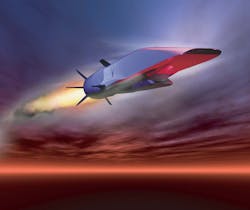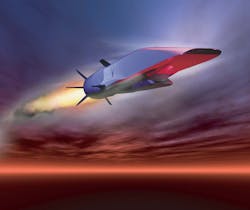Boeing, Pratt & Whitney Rocketdyne, AFRL, and DARPA partner on X-51A WaveRider, achieve record-breaking flight
CANOGA PARK, Calif., 17 May 2013. The X-51A WaveRider hypersonic vehicle achieved the longest supersonic combustion ramjet-powered flight--flying full duration and achieving both mission success and aviation history on May 1.
The X-51A program is a collaborative effort of the U.S. Air Force Research Laboratory (AFRL), the Defense Advanced Research Projects Agency (DARPA), Boeing, and Pratt & Whitney Rocketdyne.
An SJY61 scramjet engine from Pratt & Whitney Rocketdyne, a United Technologies Corp. (NYSE:UTX) company, powered the X-51A on the historic flight.
"The X-51A is a critical element in our progression to practical hypersonic propulsion, providing a greater understanding of hypersonic propulsion performance, control and structural durability," says George Thum, X-51A program manager, Pratt & Whitney Rocketdyne.
"This test flight brings aviation closer than ever to the reality of regular, sustained hypersonic flight," says Jim Maser, president of Pratt & Whitney Rocketdyne.
During this, the X-51A's fourth and final planned flight, the unmanned WaveRider vehicle was carried beneath the wing of a U.S. Air Force B-52 and dropped from an altitude of about 50,000 feet over the Pacific Ocean off southern California. A solid rocket booster fired and propelled the cruiser to scramjet takeover, creating the supersonic environment necessary to operate the engine.
The scramjet propelled the cruiser more than 230 nautical miles in approximately six minutes, streaking through the sky from Mach 4.8 to Mach 5.1 while climbing in altitude. The engine ran full duration, depleting all fuel as planned. It was the longest of the four X-51A test flights and the longest air-breathing hypersonic flight in history. Early indications show the propulsion system accomplished all objectives.
"It was a full mission success," remarks Charlie Brink, X-51A program manager for the Air Force Research Laboratory Aerospace Systems Directorate. "I believe all we have learned from the X-51A WaveRider will serve as the bedrock for future hypersonics research and ultimately the practical application of hypersonic flight."


